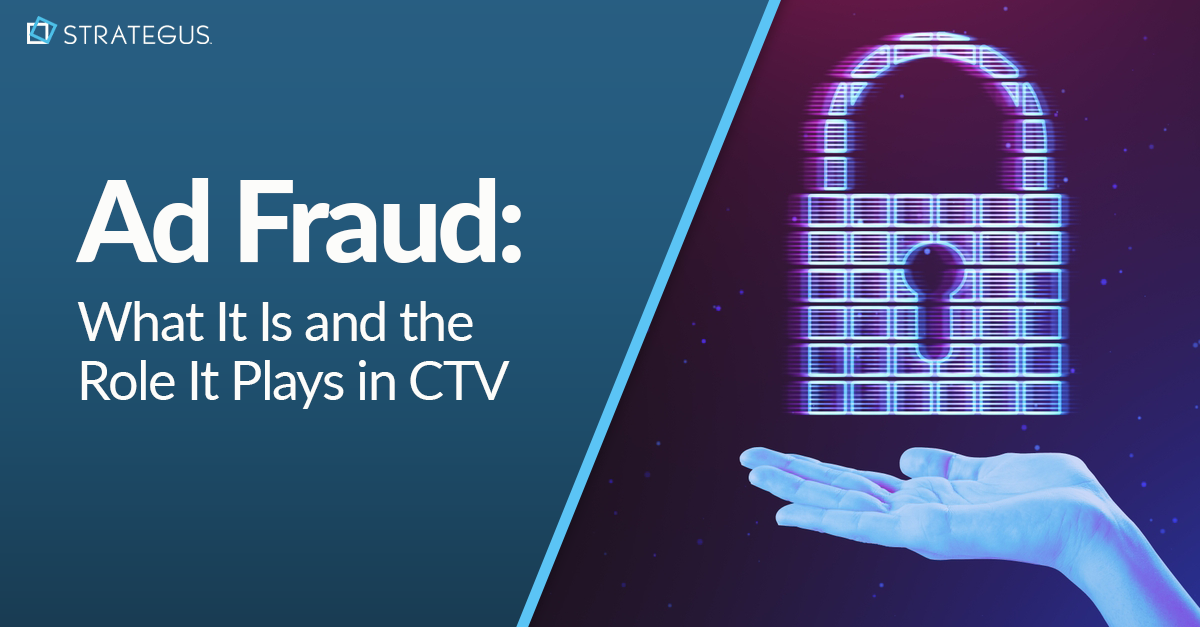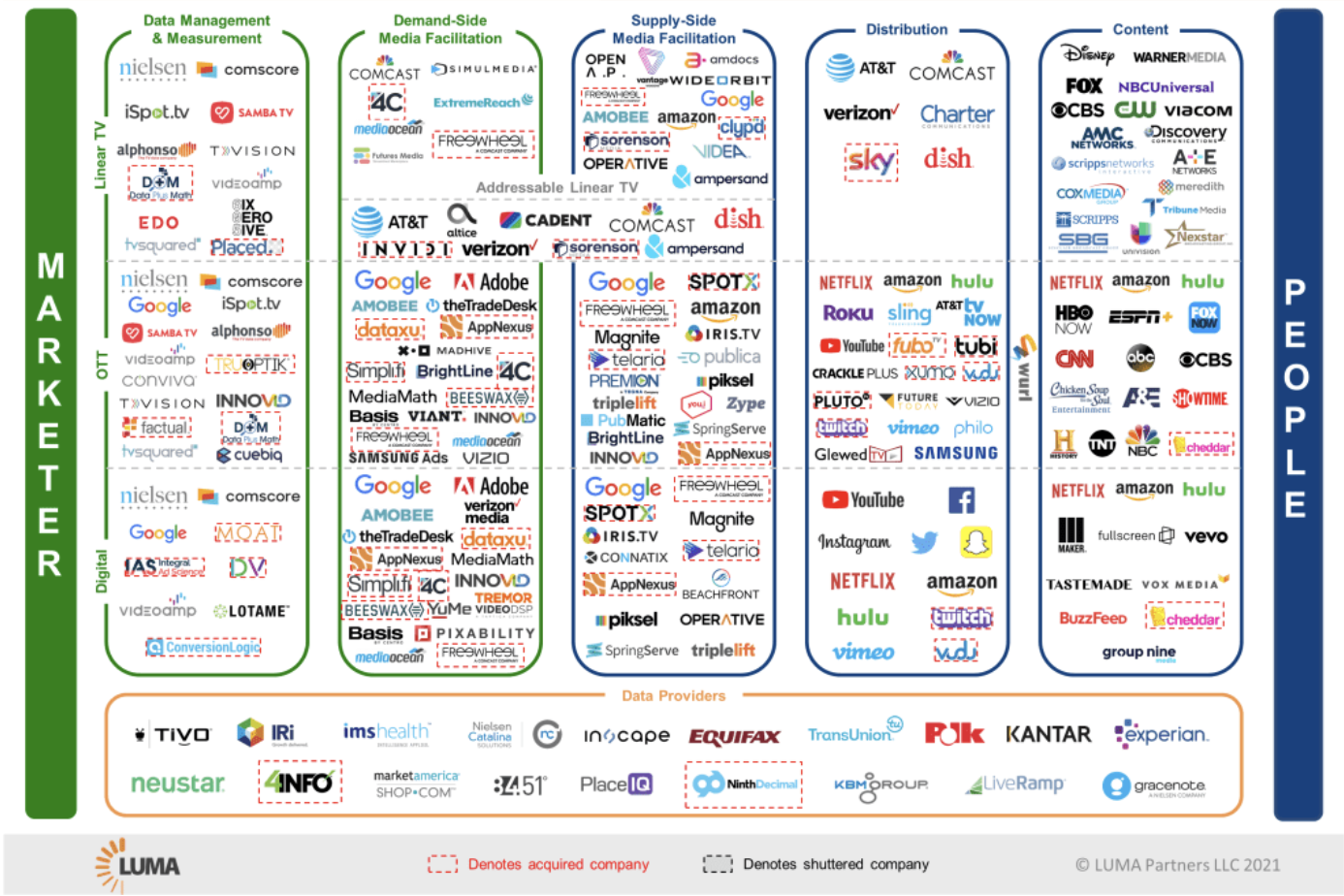- Home
- Strategus Blog
- Ad Fraud: What It Is and the Role It Plays in CTV
Ad Fraud: What It Is and the Role It Plays in CTV
 Traci Ruether
Traci Ruether
13 minutes read

Connected TV (CTV) is the fastest-growing ad channel in U.S., predicted to account for $42.4 billion in ad spend by 2027. But as CTV investment grows, so does the possibility of fraud.
In this article, we nail down what ad fraud is, the different types of ad fraud that marketers should be aware of, and the tactics that Strategus has in place to safeguard the agencies and brands we partner with.
The TL;DR is nothing groundbreaking: Thwarting ad fraud comes down to transparency and accountability, the right partnerships, and hands-on campaign monitoring. In other words, ad fraud can easily be prevented with the proper tools and partnerships
But not all advertisers have the time or resources to check all these boxes. Which is why at Strategus, we deliver on all accounts with a proactive approach.
Keep reading for the skinny.
What Is Ad Fraud?
Ad fraud describes any situation where a marketer is misled about the placement, performance, or validity of the media they purchase. Often done for financial gain, this can take the form of bots clicking on pay-per-click ads, misleading data about ad impressions, ads that are displayed in such a way that no humans see them, or even fake video views on connected TV devices.
The objective of ad fraud is money. Essentially, bad actors and fraudulent publishers trick marketers into paying for efforts that have little to no ROI. Because these types of media buys are often cheaper than legitimate ones, marketers are lured by the price point.
Also called advertising fraud or digital ad fraud, these schemes are largely bot-driven today. Automated software programs simulate user engagement by generating fake impressions, clicks, or conversion data. This inflates ad metrics, deceiving advertisers and ad networks into paying for ineffective placements.
That said, humans can also be at fault. Click farms, for example, employ real people to manually click on ads, creating a facade of legitimate user engagement. And if we’re being honest, even typing a competitor’s name into Google and clicking on a paid ad to tank their ROI is a form of click fraud.
What Are Common Ad Fraud Prevention Tactics?
Various strategies have been developed to combat ad fraud. Because there’s no silver bullet, your best bet is layering multiple tactics. Even better, marketers should cover all their bases by employing every method listed below — which is exactly what we do here at Strategus.
Ad fraud prevention tactics include:
- Ad verification services: Partnering with independent companies like DoubleVerify that analyze ad traffic to identify and block fraudulent activity.
- Real-time bidding (RTB) filters: Setting parameters within programmatic auctions to exclude suspicious traffic based on factors like IP address or device type.
- Human review: Manual checks by trained analysts (like the Strategus AdOps team) to identify anomalies that automated systems may miss.
- Device and IP filtering: Blocking traffic from known bad actors or suspicious geographic locations.
- Viewability metrics: Monitoring metrics to verify that ads are seen by real users for a sufficient duration.
- Geolocation targeting: Confining ad delivery to specific regions relevant to the campaign.
- Campaign monitoring: Closely tracking metrics to identify sudden spikes or unexpected patterns that could indicate fraud.
- Collaborative efforts: Industry-wide initiatives to share information and develop common standards for fighting ad fraud.
While there are technologies to automate ad fraud prevention, the programmatic ecosystem changes daily. That’s why constant policing — often through manual efforts — is crucial.
The more eyes you have on your campaign metrics, the better off you’ll be. Likewise, the more experience you have on your AdOps team (whether in-house or via a managed services partner like Strategus), the better positioned you are to catch costly errors before they impact business.
What Is CTV Ad Fraud?
CTV ad fraud, by extension, is when advertisers are misled about the placement or performance of their connected TV ads. These schemes take advantage of the fragmentation across the CTV supply chain, which is why cross-publisher data transparency is such a critical requirement.

(Source: Luma Partners)
The main risk of CTV ad fraud is wasted spend. Advertisers end up paying money for efforts that do little to drive brand awareness or conversions. Data inaccuracy also occurs, which can misguide strategy and skew campaign performance.
In some cases, ad fraud can also compromise a brand's reputation. Imagine thinking your ads are running on a service like Hulu, and instead find out they're playing alongside politically charged TikTik videos.
While these ads may still convert, they don’t fall in the category of ‘brand-safe inventory.’ And besides, a true CTV campaign shouldn’t start with a personal device. Connected TVs, by definition, are the big screens in our living rooms (and not the phone screens that we check while on the go).
To this end, you should vet potential CTV partners by asking questions like:
- Can you tell me about the CTV content where your ads run?
- What percentage of your CTV campaigns run on smart TVs?
- Do you offer a reporting dashboard with continuous access to clients?
- What kind of reporting will I receive, and how frequently?
- How much control will I have over where my ads are placed and which websites they appear on?
- How do you handle ad fraud and ensure my ads are not displayed on fraudulent or low-quality websites?
Types of CTV Ad Fraud
So what does CTV ad fraud look like? It can take a few different forms, including:
- Fake CTV devices: Fraudsters can create software that mimics real CTV devices, generating false ad impressions. These devices can be programmed to watch ads 24/7, inflating viewership numbers and draining advertisers’ budgets.
- App bundling: Malicious apps can be bundled with legitimate CTV apps. These bundled apps then secretly run in the background, displaying and registering ad views without the user's knowledge.
- Pixel stuffing: This involves placing an invisible ad unit (a single pixel) on a legitimate CTV app. When a user interacts with the app, they unknowingly trigger the invisible ad to register a view, generating fraudulent impressions.
- Traffic spoofing: Fraudsters can manipulate device IDs and IP addresses to make it appear as though real ad impressions are coming from legitimate viewers.
- Server-side-ad-insertion (SSAI) spoofing: SSAI spoofing happens when fraudsters distribute millions of ad requests from data centers pretending to be CTV devices. No actual viewers ever see these ads, as the inventory SSAI spoofing generates is fake.
- Geographic misrepresentation: This occurs when fraudsters sell ads that they claim are being shown to U.S. viewers, that are, in fact, being shown to viewers in developing countries with a lower CPM.
- Seller-based deception: In the same vein as MFA fraud, seller-based deception occurs when CTV platforms or sellers misrepresent the inventory or audience data. This is why it’s so crucial to prioritize premium inventory and find a CTV ad partner Strategus that can conduct measurement across different publishers to identify the highest-performing tactics for your campaigns.
Do note: CTV ad fraud is far less common than other types of digital ad fraud. While ad fraud at large accounts for 10.3% of total ad spend, CTV ad fraud only accounts for ~1.3% of total CTV spend. It’s also less likely to negatively impact viewers in the way that pop-up ads and computer viruses do in non-CTV ad fraud schemes.
Strategies for Curbing CTV Ad Fraud
Having established that the premium environment of CTV advertising significantly lowers the chances of fraudulent ad activity, there are still safeguards that advertisers can employ to stay ahead of malicious activity.
1. Choose Inventory Vendors Carefully
When selecting inventory vendors for advertising, it is essential to prioritize known inventory sources and establish a robust supply path process. At Strategus, we leverage a vast array of 200+ premium publishers to ensure that the brands and agencies who partner with us can take advantage of both quality and scale.
We also guarantee that our CTV inventory meets the following standards:
- Premium: Our customers’ ads are only placed within high-quality content from sought-after publishers like HGTV and Discovery.
- Long-form: We require that shows and movies be 22 minutes in length or longer to reach captivated viewers.
- Not user-generated: User-generated content (UGC) falls outside of the realm of premium CTV, so we only serve ads on professionally produced content.
2. Know Your Audience and Demand Transparency
Effective CTV advertising starts with understanding your audience and their behavior. This can equip you to match peak user activity times for relevant displays and detect any deviations.
From there, demand detailed reporting and 24/7 transparency from your CTV ad partner. After all, your marketing strategy is only as good as your data — and without around-the-clock visibility you could miss out on opportunities to maximize results.
Say you’re targeting stay-at-home moms in the Denver metro area and your reporting dashboard shows ad impressions occurring at 3 a.m. across the West Coast. Immediately, you would know something was wrong — which is why campaign monitoring remains one of the most bulletproof defenses against ad fraud.
At Strategus, we take this one step further by getting to know you, your brand, your goals, and your audience. After we plan and launch your campaigns, our team continuously optimizes them based on real-time data. This type of hands-on-keyboard policing simply can’t yet be replicated by automated ad fraud technologies.
3. Take Advantage of Fraud Detection Tools
Ad verification tools, ad-blocking technology, and CTV measurement companies are all necessary safeguards against ad fraud. We’d recommend working directly with companies like DeviceAtlas and IAS or finding a partner like Strategus that’s already forged relationships with intelligence vendors across the industry.
4. Stay Informed on CTV Industry Standards
The CTV industry changes daily. As such, CTV best practices and fraudulent tactics are constantly evolving.
This is where brands and agencies benefit from the hands-on approach of a managed service CTV provider. By working with industry experts, you’ll immediately benefit from the experience, analytics tools, and knowledge required to stay at the cutting edge.
Other Forms of Digital Ad Fraud to Monitor
If you’re executing CTV campaigns, chances are you’re also buying media across the programmatic ecosystem. There are additional forms of ad fraud that come into play in the digital advertising space at large, so here’s a quick list.
Ad Stacking
As a common form of display advertising deception, ad stacking occurs when multiple ads are layered on top of each other within a single ad placement. While only the top ad is visible to users, all ads hidden beneath the primary ad are counted as impressions, leading to inflated metrics and fraudulent billing. Because advertisers are often charged on a per-impression basis, this results in spending money on unseen ads.
Pixel Stuffing
Similar to ad stacking, this involves placing ads within a pixel so small that it’s practically invisible. An entire webpage could have numerous ads stacked in the invisible pixel to generate fake impressions.
Device Spoofing
This occurs when bad actors manipulate the identity of their devices to appear as different devices. While multiple clicks coming from a single device would signal fraud, this approach obscures the device data so that it’s harder to detect.
Click Fraud
Also known as pay-per-click fraud, click fraud occurs when bad actors use automated and manual clicking programs to create the illusion of clicks from real buyers. This tactic doesn’t just inflate engagement metrics, it directly targets your budget by generating fake clicks on your ads.
These clicks come from:
- Automated clicking programs: Bots mimic real users by clicking on your ads, often quickly and repeatedly. This creates the illusion of high engagement, but there's no genuine interest in your product or service.
- Click farms: These operations employ large numbers of low-quality devices (often smartphones) to generate fraudulent clicks. The devices can be physically located in one place or spread across the globe.
MFA Fraud
A recent Adalytics report put major brands like Forbes under fire for misleading the advertisers who purchased media on their sites. The controversy focused on a distinct flavor of programmatic ad fraud: made-for-advertising (MFA) sites.
We’ve all seen them. Often, a clickbait headline stops your scroll, luring you to click through to a spammy site (even though you know better). Next thing you know, you land on a dumpster fire of a website, where the content you’re trying to find is buried beneath countless competing display ads.
If you do stick around, you’ll likely have to click through to multiple pages to read the full article. Even worse, you may unintentionally click on an ad due to the misleading site navigation.
According to the Trade Desk, “Key identifiers of MFA include, but are not limited to the following: content/page quality, ad refresh rates, and paid traffic sourcing rates and other anomalous traffic patterns”
The Need for Cross-Device Ad Fraud Prevention
At Strategus, we combine big-screen CTV ads with retargeting across the programmatic ecosystem. This comprehensive approach means we stay vigilant against all these forms of ad fraud, not just those specific to CTV.
We constantly vet new partners and deliver out-of-the-box integrations with intelligence and ad fraud detection companies to ensure maximum accountability for the media buyers and brand marketers we represent.
How Does Ad Fraud Detection Work?
Ad fraud can be detected through various methods, from analyzing engagement metrics and monitoring irregularities to proactively flagging certain attributes of the inventory where ads will run.
MFA sites, for example, can be identified based on the following attributes:
- Page load time
- Ad-to-content-ratio
- Percentage of paid traffic
- Rapid ad placement refreshes
- Content quality (non-editorial and templated)
- Website design (poor designs using WordPress templates)
Partnering with trusted ad fraud detection companies allows us to combine proactive data analysis with hands-on monitoring to effectively combat ad fraud.
Ad Fraud Detection Companies
Here’s a look at the industry-leading platforms that help us detect, prevent, and mitigate the risks associated with fraudulent ad interactions.
Integral Ad Science (IAS)
IAS is a prominent provider of ad verification and optimization solutions. Their comprehensive suite of tools ensures the quality and safety of ad placements. The IAS Threat Lab actively monitors campaigns to detect fraudulent activity, while improving ad placements to maximize performance and ROI.
Peer39
Peer39 plays a crucial role in brand safety by assessing the context in real time to minimize the risk of low-quality or harmful content. By analyzing the content and context of web pages, Peer39 provides accurate and granular insights into the suitability and safety of ad placements.
Moreover, they verify ad viewability, guaranteeing that ads are genuinely seen by human audiences, and offer valuable insights into visibility and engagement metrics for ad placements.
DoubleVerify
DoubleVerify’s extensive suite of services includes ad verification, viewability measurement, and brand safety monitoring. By analyzing over 2 billion impressions daily, DoubleVerify identifies comprehensive fraud and invalid traffic — from hijacked devices to bot fraud and injected ads.
How Strategus Provides Ad Fraud Protection
Ad fraud can be alarming, but it’s also easy to mitigate with the right precautions.
In addition to partnering with all the ad fraud detection companies detailed above, we employ a comprehensive approach at Strategus to stop fraud in its tracks:
- We utilize premium inventory, and overlay brand safety filters including whitelists/blacklists and third-party tech to avoid dubious impressions pre-bid.
- We integrate with HUMAN, an industry-leading cyber security firm, to scan and block fraudulent biddable impressions before purchase. This industry-leading, platform-level integration is the first of its kind, designed to defund ad fraud at scale.
- Our senior-level Ad Operations Managers proactively monitor campaigns and take immediate action when needed. With a deep understanding of the CTV landscape, they have the expertise needed to navigate potential fraud risks and make data-driven optimizations.
- Our 24/7 reporting dashboard offers real-time insight into campaign performance, while our attribution suite provides visibility into every touchpoint to distinguish real engagements from fake ones.
- Finally, we provide supply chain transparency with Ads.txt and App-ads.txt.
Does CTV ad fraud exist? Yes. Is it resource-intensive to prevent? Unfortunately, it is. But by working with an industry-leading CTV partner, you have nothing to worry about.
Contact us today to learn more.

Traci Ruether is a content marketing consultant specializing in video tech. With over a decade of experience leading content strategy, she takes a metrics-driven approach to storytelling that drives traffic to her clients' websites. Follow her on LinkedIn or learn more at traciruether.com.
Strategus is a managed services connected TV(CTV) advertising agency with over 60,000+ campaigns delivered. Find out how our experts can extend your team and drive the result that matter most.
Talk to an Expert
Table of Contents
Seeking a Custom CTV Strategy That Delivers?
What to read next

Best SVOD Platforms for Advertisers
The streaming wars have a new battlefront, and this time, it's all about your ad budget. Just a few years ago, SVOD meant "no commercials." Now, it...
12 minutes read

Third-Party Data Targeting for CTV: Benefits & Tactics
Third-party data. It’s a term that’s thrown around, and yet few take the time to detail its pros and cons — much less strategies for using...
7 minutes read

First-Party Data Targeting: Benefits and Tactics for CTV Advertising
First-party data is the information that companies collect directly from their customers rather than through intermediaries. Advertisers use this...
10 minutes read

Foot-Traffic Attribution: Tying Ad Impressions to In-Store Visits
The marketing funnel has changed. Today’s shoppers often begin researching products from the comfort of their homes and don’t set foot into a store...
8 minutes read
















